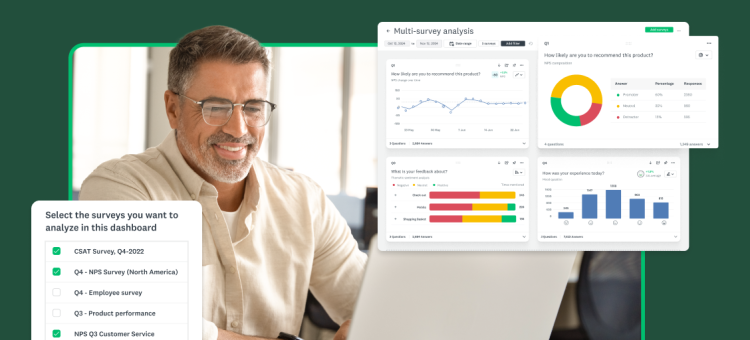Measuring customer satisfaction allows you to comprehensively record the customer experience (CX). Using different types of customer satisfaction metrics, you can paint the full picture of how your customers respond to your brand.
Collecting feedback allows you to monitor your customer experience metrics with concrete data. Responding to this feedback helps you improve your customer touchpoints over time and create a better customer experience.
As you streamline the customer journey at every touchpoint, your customers will report higher satisfaction. From there, you’ll experience higher profits, decreased churn and happier customers, so what's not to love?
Customer satisfaction key performance indicators (KPIs)
Satisfying your customers is one of your business's most important goals. In fact, 91% of customers who have a positive experience with your brand will recommend your company. Improving the customer experience over time can boost customer satisfaction and enhance everything from retention rates to overall revenue.
Measuring customer satisfaction is the key to success. Clear, quantifiable metrics will offer you the insight you need to monitor and develop a strategy to improve customer satisfaction. Improving satisfaction can:
- Drive customer loyalty: happier customers are more likely to return to your business for future purchases.
- Reduce churn rates: high satisfaction rates lead to lower customer churn.
- Generate word of mouth: customers who love your brand will recommend you to friends and family, helping bring in new customers and boost revenue.
- Develop brand reputation: If you have many satisfied customers who recommend your brand, you’ll develop a positive brand reputation that can attract new customers.
Developing a Voice of the Customer (VoC) programme that measures customer satisfaction using various metrics can help your business achieve all these benefits and more. Let’s dive into some important metrics to consider when measuring customer satisfaction.
Related reading: Customer satisfaction surveys: Examples and tips for getting started
Which metrics measure customer satisfaction?
Customer satisfaction is one of many key performance indicators (KPIs) that enterprises routinely measure. Customer satisfaction has several facets, ranging from how loyal a customer feels to whether or not they find interacting with your company difficult.
Measuring your customer satisfaction allows you to create a plan to improve it. You can use the following metrics to measure customer satisfaction holistically.
Related reading: How to run a successful VoC programme
Net Promoter® Score (NPS®)
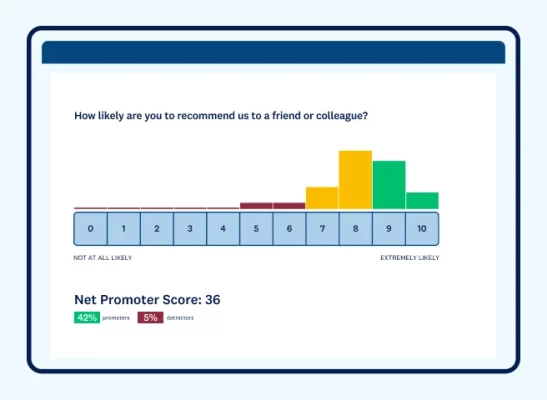
The Net Promoter Score is a metric that businesses use to monitor levels of customer loyalty. Brands all across the world now consider measuring NPS to be the leading method of tracking customer loyalty.
The NPS produces a number of between -100 and 100 that you can use to monitor your customer loyalty. Measuring brand loyalty with NPS allows your brand to trace how customers respond to your business over time. As you implement strategies to improve the customer experience, you can track how satisfaction increases by routinely taking this loyalty metric.
Using an NPS survey to measure loyalty is useful as the survey is simple and effective. Businesses only need to ask a close variant of “How likely are you to recommend our company to a friend or colleague?” Answers can range on a scale from 1 to 10.
Businesses then divide their customers into three groups based on the scale:
- Detractors (0–6): Customers who are unhappy with the services or products you provide and are likely to have a negative impact on your brand reputation.
- Passives (7–8): These are customers who are indifferent to your business and may switch to a competitor.
- Promoters (9–10): Customers who are loyal to your business and will bring in new clients through positive word-of-mouth referrals.
By using the following formula, you can work out your NPS score. Benchmark this score against your competitors or your industry average to see how your customers feel about your brand.

Customer Satisfaction (CSAT) Score
The Customer Satisfaction Score allows businesses to directly measure customer satisfaction with their company, products or services. Its aim is to monitor overall satisfaction while also identifying areas where an organisation could improve its offerings.
The CSAT score produces a percentage that you can compare to benchmarks to determine whether your company is doing better or worse than your industry average. As an accurate way to measure customer satisfaction, this metric can help you monitor and improve customer retention and build better customer relationships.
A CSAT survey asks users “How would you rate your overall satisfaction with [Company/Product/Service]?” Respondents can choose from a scale of 1 (very unsatisfied) to 5 (very satisfied).
Companies can work out their CSAT score using the following formula:
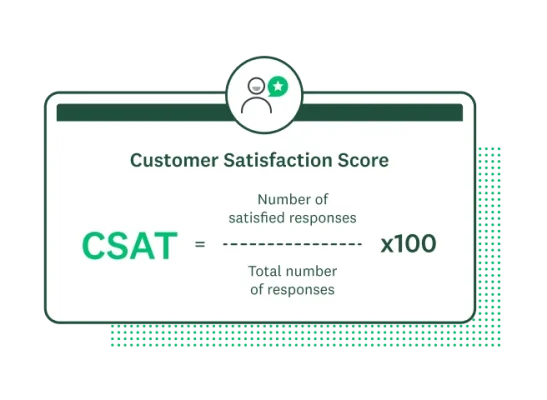
Related reading: 50 examples of great customer satisfaction survey questions
Customer Effort Score (CES)
The Customer Effort Score measures the relative effort it takes for a customer to complete a certain interaction with your company. Its aim is to record effort at important customer touchpoints in order to streamline the customer experience.
If customers feel that interacting with your business, whether talking to support or buying something, is too difficult, they simply won’t do it. Reducing the effort that customers have to exhibit will lead to a smooth, frictionless experience.
You can trigger a CES survey whenever a customer finishes interacting with a core touchpoint. A CES survey will state “[Company] made it easy to [touchpoint].” Respondents will then choose a response from 1 (strongly agree) to 5 (strongly disagree).
Companies can use the following formula to get a fixed CES score, which will range from 0 to 100. By taking action on customer feedback, businesses can improve the customer experience at each touchpoint, reduce effort and boost overall satisfaction.
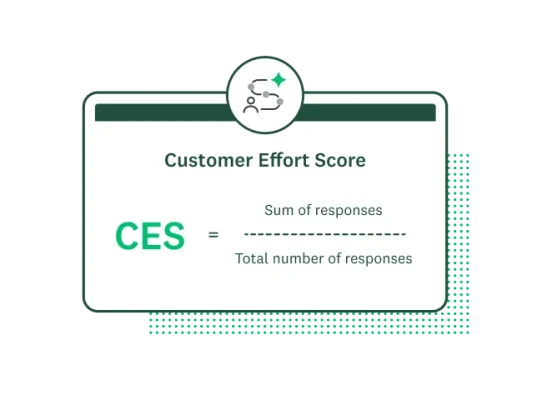
Customer Retention Rate
Your company's customer retention rate is a measure of how effective your business is at preventing customers from churning. If your customers are happy enough to continue buying, it's likely that they will feel satisfied with your products and service.
On the other hand, lower rates could signify that your customers feel disappointed with your business. By measuring your retention rates over time, you can determine whether your customer experience management strategies are having a positive effect. Improving customer loyalty and retention can help to improve profits and boost customer lifetime value.
You can measure the customer retention rate by using the following formula:
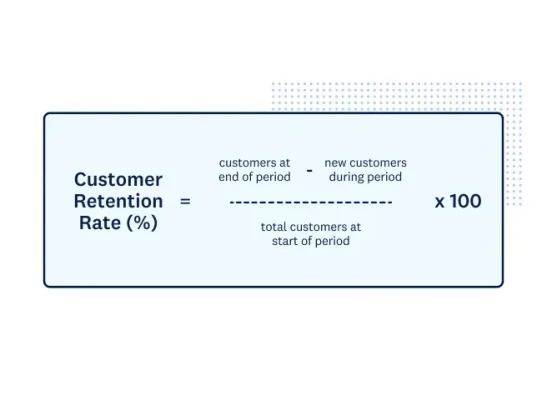
Customer Lifetime Value (CLV)
Customer lifetime value is a metric that measures the overall amount of revenue that a customer produces for your business across their entire lifetime with your company. Every purchase a customer makes – from their first to their last – contributes to their CLV.
A customer with a high average CLV could suggest that the business has customers who routinely return to purchase again. Low CLVs may signify that customers purchase once but never again. In the latter case, your products and services may not be meeting customer expectations.
Monitoring and improving your CLV over time will help to increase your revenue while decreasing customer churn. Here’s how to calculate customer lifetime value:
Average purchase cost x number of purchases across a customer journey = CLV
You can calculate CLV for specific segments, individual customers or your entire business.
Get more from your customer satisfaction KPIs
The more data you have on your customers, the better equipped your business is to serve them. These customer satisfaction metrics will help you understand how your customers feel about your products, services and experiences.
By measuring satisfaction KPIs and closely monitoring each metric over time, you can trace the impact of your customer experience management strategies. With satisfied customers comes higher profits, increased loyalty and a better bottom line for your business.
Learn more about improving customer satisfaction with the SurveyMonkey ultimate guide to the Customer Satisfaction Score. Alternatively, take a look at the CSAT use cases to learn more about how SurveyMonkey can help your organisation.
Your best customers are the ones you already have
Identify and address customer pain points and drive higher satisfaction rates with SurveyMonkey.
NPS®, Net Promoter® and Net Promoter® Score are registered trademarks of Satmetrix Systems, Inc., Bain & Company and Fred Reichheld.


